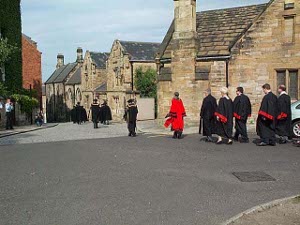 Durham Castle keep
established power: the church.
Durham Castle keep
established power: the church.
It just goes to show what happens when you try to solve a problem the easy way: When William the Conqueror took over England, back in the eleventh century, he wanted to make sure to retain control. The first prince he selected was murdered almost at once, so William decided to rely on the already  Durham Castle keep
established power: the church.
Durham Castle keep
established power: the church.
He created the Prince Bishops. That is, the Bishop of Durham acquired the additional role and status of Prince, becoming the secular as well as the religious ruler of Northeast England. Pretty soon the Prince Bishops had raised enough taxes and tithes and income from fines to build not only the elegant cathedral, but also a castle, originally justified for defensive purposes, but evolving into a magnificent residence. By the 1830s, when the last Prince Bishop died, pomp had reached the point where the Prince Bishop didn't walk the short distance from his castle across the green to the cathedral. Instead he rode In a coach pulled by eight beautifully matched horses.
The University of Durham was established in the early 1800s, and was the recipient of the castle at the death of the last prince bishop. They have used the building for student residences and dining.
The young theology student guiding the tour today has a healthy disrespect for the conspicuous consumption of the first tenants of the castle.  Council procession
There's a story that a Latin grace was inscribed on the hatchway between the kitchen and the Great Hall, so that dinner wouldn't get cold while the diners waited to say Grace. Whether that's true, it is true that the beautiful large brick oven, built about 1200, was at its time the largest and most elaborate in Europe, the brickwork attracting admirers from the Continent. The imposing Castle Keep was a just-pre-Victorian addition, and was never part of the defenses; it is a dormitory now for about 50 lucky students. The original door to the castle, complete with beautifully carved stonework, was considered too complicated by the Victorians. It was walled in and plastered over and whitewashed, not to be re-discovered and restored intil 1989.
Council procession
There's a story that a Latin grace was inscribed on the hatchway between the kitchen and the Great Hall, so that dinner wouldn't get cold while the diners waited to say Grace. Whether that's true, it is true that the beautiful large brick oven, built about 1200, was at its time the largest and most elaborate in Europe, the brickwork attracting admirers from the Continent. The imposing Castle Keep was a just-pre-Victorian addition, and was never part of the defenses; it is a dormitory now for about 50 lucky students. The original door to the castle, complete with beautifully carved stonework, was considered too complicated by the Victorians. It was walled in and plastered over and whitewashed, not to be re-discovered and restored intil 1989.
The same fate awaited the Norman Chapel, one of the earliest remaining Norman constructions in England, lying beneath the modern chapel. It was walled up for hundreds of years. The experts must have known of its existence, because the interior was sketched around 1800, and then it was walled up again. Today it is open and on the tour, where we appreciated the soaring Gothic arches like those in the cathedral, and the beautiful carvings of Biblical scenes on the pillars.
 Durham rooftops
Durham rooftops
The Castle tour ended at 3:20. Evensong at the Cathedral was just too good an opportunity to miss. A choir from a nearby parish, filling in for the Cathedral choristers who are on holiday (mid-term break at the University) provided lovely anthems for this special beginning-of-the-civic-year service featuring the Durham Mayor and Council. The beginning of service procession was led by the mayor in his scarlet ermine-trimmed robe, guarded by a leader tapping his ceremonial cane with each step, a sword bearer, and eight ancient bodyguards in black hats and robes, many medals, each carrying a mace or a pike. Following the bodyguard marched the councilmembers, each in his or her scarlet-trimmed black gown. Apparently Durham is the only English city outside of London to preserve this tradition. Following the service, the entire procession strode down the cobbled street from the cathedral into Market Square and disappeared into City Hall.